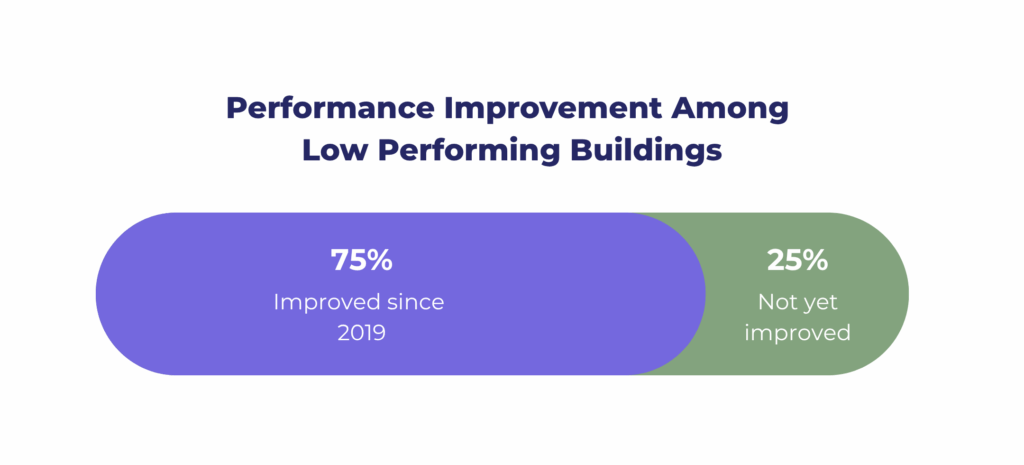With adoption of the Clean Energy Omnibus Act of 2018, DC became the first jurisdiction to require building owners meet building performance requirements and the results so far are promising. The data shows that DC’s Building Energy Performance Standard (BEPS) is already improving energy efficiency, lowering energy use, and reducing greenhouse gas emissions. This means building owners and tenants are already spending less on utility bills, and the local grid is better equipped to handle peak energy loads ahead of the first BEPS deadline approaching at the end of 2026.

75% of privately-owned buildings required to comply with DC’s Building Energy Performance Standards (BEPS) have improved since the 2019 baseline.
Data summary
The Building Innovation Hub (Hub), a project of IMT, conducted a high-level analysis of the 2023 third-party verified, DOEE-accepted benchmarking data (the most complete dataset available) in comparison to 2019 performance for privately-owned low performing buildings.
Our findings are as follows:
- 75% of buildings have improved their performance since 2019.
- 45% of low performing buildings have opted to comply via the “Performance Compliance Pathway”. Of these buildings:
- 30% improved their energy efficiency by over 20% and so were likely already complying with BEPS well ahead of the 2026 deadline.
- The numbers are even higher for office buildings: 43% had improved by over 20% in 2023, and 90% had improved by at least 5%.
- Multifamily buildings are also making progress, with 64% improving efficiency by over 5%, and 19% improving efficiency by over 20%.
- 50% of low performing buildings have opted to comply via the “Standard Target Compliance Pathway”. Of these buildings:
- A remarkable 60% had ENERGY STAR scores that were already higher than the minimum standard, essentially guaranteeing compliance if they maintain performance through the end of the cycle.
- Most office buildings are on track, with 65% already meeting or exceeding the BEPS standard of a 71 ENERGY STAR score.
- Multifamily buildings are not far behind, with 54% scoring higher than the standard of a 66 ENERGY STAR score.
The data suggests that building owners are making investments that improve building efficiency and seeing significant savings.
Notes on the data
Data used in this analysis was pulled from DC’s Energy Benchmarking OpenData and DC’s Building Energy Performance OpenData website on March 25, 2025 and relevant information from both datasets were merged. Buildings included in this analysis met the following parameters:
- Privately owned buildings that need to take action to comply with BEPS (status in disclosure is “Does Not Meet BEPS”).
- 2023 benchmarking data is “In Compliance” with DOEE, which indicates the data was third-party verified and DOEE has accepted the benchmarking submission.
- Excluded buildings on the Performance Pathway missing 2019 benchmarking data (baseline data).
- Excluded buildings on the Standard Pathway without ENERGY STAR scores.

